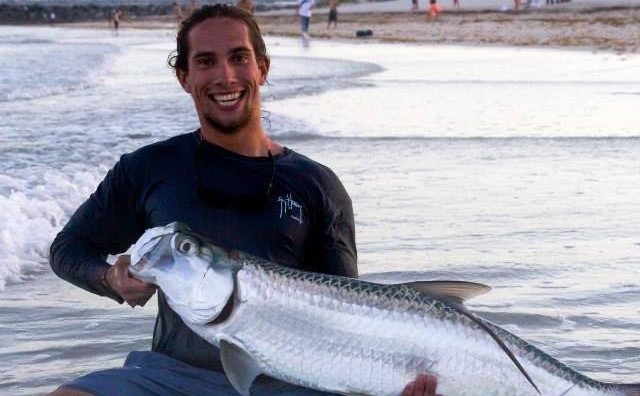

The ocean was rippling and dark with white explosions off the coast of South Beach when Kevin Rodriguez, University of Miami senior and Miami native, went to fish after class one October afternoon three years ago. He was witnessing a school of mullet fish the size of a football field being attacked by giant predatory fish including sharks and tarpon just a few feet offshore. He hurriedly cast his mullet fish into the water and instantly caught a tarpon, the first of the five tarpon weighing over 100 pounds that he would catch within two hours that evening.
The mullet run is a massive southward migration of mullet before they move offshore to spawn. Mullet are schooling, silvery fishes found in tropical and temperate regions that feed on detritus, plants and small animals and are consumed by larger fish species. Mullet predators include giant tarpon, sharks, jacks and snook fish that are attracted to the large schools of the migration. Cooler temperatures and shorter days trigger the mass exodus of these fishes from northern waters. The mullet often reach South Florida by early October, bringing the large predatory fish to the coast of Miami with them.
In celebration of this event, the UM Fishing Club is hosting a mullet run tournament that began on Oct. 6 and will end on Nov. 20. Prizes from Guy Harvey and American Fish Tackle Company will be given to those who catch the largest tarpon and the largest snook along with three people who receive the most points based on a system that accounts for size and total take, UM Fishing Club Event Coordinator Steven Buibish said. Entrants must be members of the club and must have attended at least one meeting by the end of the tournament.
This year, the mullet run reached Miami a couple weeks ago, according to UM Fishing Club Co-President Scott Rose. This fisherman’s heaven and sunbather’s hell lasts one to two months each fall.
“It’s in full force this upcoming week,” Rose said about the migration.
Fishermen anticipate the mullet run because anyone can catch a large predatory fish from the coast, a pier or a bridge. Being fortunate enough to have access to a boat is not necessary for high-reward fishing during this time of year. Also, free bait is provided. Just throw in a cast net over a region of the mullet school, and you’ll have yourself tens to hundreds of baitfish.
“Every single mullet I threw in the water was immediately destroyed, and the guys next to me were catching back-to-back snook. It was truly amazing,” Rodriguez said. He has been fishing off of the coast of South Florida since he was five years old. He was reminiscing about his favorite experience while fishing the mullet run.
Beachgoers do not need to worry. Sure, there are more sharks at this time of year due to prey fish migration, but bathers are not currently at risk, Miami Beach Patrol Ocean Rescue Operations Supervisor Scott Reynolds said. The predatory fish are not interested in humans and are focused solely on the incredible abundance of preferred prey all around them, Rodriguez said.





